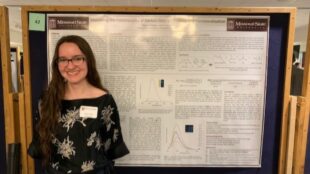Every human body must keep up with a lot of biological responses.
Biosensors help signal those that matter most.
Chemistry graduate student Megan Prado studies how to make biosensors even more useful to the demands of human life.
She recently received the Dr. Matthew and Patricia Harthcock Chemistry Research Fellowship Award to enable her to continue her graduate studies and research at Missouri State.
Prado has completed her research under the guidance of her advisor, Dr. Adam Wanekaya, department head of chemistry.
About her research
Prado tests the usability of glucose biosensors – like the continuous glucose monitoring systems some diabetics use to track the glucose levels in their blood.
Other biosensors allow food scientists to monitor glucose levels in food and drink for quality control.
But the applications don’t stop there.

“Pregnancy test devices use biosensing principles to detect the hormone HCG,” Prado said. “Other devices use them to detect oxygen levels in blood without a blood test. They can also test the amount of alcohol in a person’s system from their skin.”
Prado strives to add design aspects to her glucose biosensor that would make it more convenient for users’ applications.
The new designs could then apply to other biosensing systems.
“The goal is to create a biosensor design that is durable, flexible and easy to produce,” Prado said. “But it has to also maintain adequate signal sensitivity.”
The ink Prado uses in her biosensor has one feature that is vital to its design: a graphite base.
Why graphite?
Graphite conducts electricity.
This makes graphite-based ink suitable for creating the electrode as an electricity conductor.
“If we can ‘write’ an electrode with ink, meaning craft it with squeezable pens, then we can print the electrode onto flexible substrates by hand,” Prado said. “This allows for greater application in many different biosensor designs.”
About the Dr. Matthew and Patricia Harthcock Chemistry Research Fellowship Award
Prado received a $1,500 scholarship for the 2020-21 school year.
The award is renewable contingent on her GPA, teaching reviews and research progress.

